Airbus’ lightweight composite A320 ‘future wing’ aims to best Boeing
The new composite wing could help the A320 counter Boeing’s proposed 737 successor.

A good decade ago, Airbus added more fuel-efficient engines to its A320 aircraft family, giving its already bestselling model a dramatic demand boost. Now the European company is seeking to repeat that success, this time with a new set of wings.
Airbus aims to produce a composite wing that’s both affordable and capable of a high production rate, according to Sue Partridge, who heads the company’s future-wing project. Assembly of the first demonstrator is set to start in the next few weeks.
A new lightweight wing may be deployed on an upgraded version of the A320 series, allowing Airbus to harvest more efficiencies from its largest existing single-aisle jets.
The move would have the benefit of giving Airbus a ready response should arch-rival Boeing choose to go ahead with a new aircraft after its 737 narrow-body reached the limits of development.
“The most immediate application would be if they decide to do a final stretch of the A320neo family,” said Agency Partners analyst Sash Tusa. “They’ve cleaned up the wing an awful lot but they’ve never done a proper re-winging of that aircraft.”
The European firm is already gauging customer interest in a stretch of the A321 – commonly called the A322 – following a strategy review last year, according to people familiar with the matter. Court documents have also shown that it has solicited engine ideas from General Electric regarding a next-generation narrow-body jetliner.
Complex structure
While wings are among the most complex pieces of engineering on an aircraft, designing from a metal to a composite design would still come at only a fraction of the cost of an all-new aircraft, while deliver significant savings for operators.
Airbus has made some upgrades to the structure over the years, adding wing-tips that reduce aerodynamic swirl, for example, but the wing has remained largely the same from when the A320 was introduced late in the 1980s.
Tusa said a “radical” A320 makeover including modifications to house bigger engines would likely cost in excess of €4 billion (US$4.9 billion), still far less the US$15-$20 billion expense of an all-new aircraft for Boeing.
The future wing will be built longer and thinner to improve aerodynamic performance and fuel efficiency, with the added span requiring folding tips in order to access existing airport gates.
The wing will also draw on increased automation and new manufacturing techniques to simplify production, Partridge said in an interview.
Airbus’ wing project will be wrapped up in 2023, and the next step will be to sharpen the technology for an eventual product launch, with the timeline depending on the complexity of the aircraft design, said Partridge.
Though Airbus launched the wing program – based at its Filton site in England – in 2015, it has taken on new significance in light of more recent developments. Airbus makes the wings for all its aircraft in the U.K. and flies them by cargo aircraft to the final assembly lines on the continent.
Max grounding
The grounding of Boeing’s latest Max version of the 737 after two fatal crashes gave Airbus a near two-year breathing space to consolidate what had already been a narrow lead over Boeing in the crucial short-haul jetliner market.
Just as significantly, the crisis confirmed that the 737 had reached its maximum size and range after four generations of development.
With the larger A321 version of the A320 snaffling up sales in a niche that the biggest Max 10 can’t serve, Boeing has been forced to revisit almost a decade of planning for a successor to its out-of-production 757 and twin-aisle 767.
With the new wing in its back pocket, Airbus can afford to wait for the U.S. firm to make a move and then respond having seen what it’s up against.
A stretch of the A321 to a so-called A322 model could accomodate as many as four extra rows, according to Tusa.
That would equate to 24 extra economy seats, or make a two-class layout more practicable. An all-new wing could also provide a significant range extension and potentially allow a repositioning of the landing gear to fit more-efficient engines.
Airbus has also been able to draw on lessons from the smaller A220 plane, acquired from Bombardier and the only current narrow-body with a composite wing. Engineers have worked with the Spirit AeroSystems Holdings plant in Northern Ireland that makes the structure.
Hydrogen plane
Boeing CEO Dave Calhoun has hinted that his company could introduce a new jet in a year or two, while U.K. engine maker Rolls-Royce this month became the first major supplier to confirm it’s involved in talks on the plan.
Beyond the need to respond to any move from Boeing, the new Airbus wing is likely to play a key role in development of the planned hydrogen jet.
That’s especially so since most studies envisage hydrogen being stored in the fuselage of a plane or in under-slung pods, doing away with the complication of building fuel tanks into the wing and further favoring composite construction.
Airbus CEO Guillaume Faury emphasized the role of such technology in achieving a step change in the narrow-body jet market in an interview last month.
“We think the next new platform will be significantly better than what we do today,” he told Bloomberg on April 29.
“We’re really focused on accelerating the path to de-carbonization and to the propulsion system of the future.”
Read more: Airbus reveals ‘zero emission’ commercial aircraft concepts
This article is published under license from Bloomberg Media: the original article can be viewed here